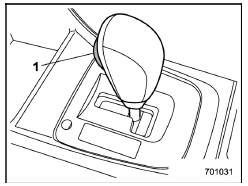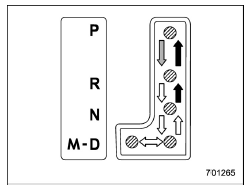Subaru Crosstrek Owners Manual: Select lever
Select lever positions

- Select lever button

 With the brake pedal depressed,
shift
while pressing the select lever button in.
With the brake pedal depressed,
shift
while pressing the select lever button in.
 Shift while pressing the select
lever
button in.
Shift while pressing the select
lever
button in.
 Shift without pressing the
select lever
button.
Shift without pressing the
select lever
button.
The select lever has four positions, "P", "R", "N", "D" and it also has an "M" gate.
NOTE
For some models, to protect the engine while the select lever is in the "P" or "N" position, the engine is controlled so that the engine speed may not become too high even if the accelerator pedal is depressed hard.
P (Park)
This position is for parking the vehicle and starting the engine. In this position, the transmission is mechanically locked to prevent the vehicle from rolling freely.
When you park the vehicle, first apply the parking brake firmly, then shift into the "P" position. Do not hold the vehicle with only the mechanical friction of the transmission.
To shift the select lever from the "P" position to any other position, you should depress the brake pedal fully then move the select lever. This prevents the vehicle from lurching when it is started.
R (Reverse)
This position is for backing the vehicle. To shift from the "N" to "R" position, stop the vehicle completely then move the lever to the "R" position while pressing the select lever button in.
When the ignition switch has been turned to the "LOCK"/"OFF" position, movement of the select lever from the "N" to "R" position is possible for a limited time period by depressing the brake pedal, and then it becomes impossible. For details, refer to "Shift lock function"F7-28.
N (Neutral)
This position is for restarting a stalled engine. In this position, the transmission is neutral, meaning that the wheels and transmission are not locked. Therefore, the vehicle will roll freely, even on the slightest incline unless the parking brake or foot brake is applied.
Avoid coasting with the transmission in neutral. Engine braking has no effect in this condition.
WARNING
Do not drive the vehicle with the select lever in the "N" (neutral) position. Engine braking has no effect in this condition and the risk of an accident is consequently increased.
NOTE
If the select lever is in the "N" position when you stop the engine for parking, you may not subsequently be able to move it to the "R" and "P" positions. If this happens, turn the ignition switch to the "ON" position. You will then be able to move the select lever to the "P" position.
D (Drive)
This position is for normal driving. The transmission shifts automatically and continuously into a suitable gear according to the vehicle speed and the acceleration you require. Also, while driving up and down a hill, the transmission assists and controls the driving performance and engine braking while corresponding to the road grade.
When more acceleration is required in "D" position, depress the accelerator pedal fully to the floor and hold that position. The transmission will automatically downshift.
In this case, the transmission will operate like a conventional automatic transmission.
When you release the pedal, the transmission will return to the original gear position.
If one of the shift paddles behind the steering wheel is operated while driving in the "D" position, the transmission will temporarily switch to the manual mode.
In this mode, you can shift into any gear position using the shift paddles. For details about the manual mode, refer to "Selection of manual mode" F7-26. Once the vehicle speed stabilizes, the transmission will switch from the manual mode back to the "D" position for normal driving.
 Continuously variable transmission features
Continuously variable transmission features
The continuously variable transmission is
electronically controlled and provides an
infinite number of forward speeds and 1
reverse speed. It also has a manual mode.
NOTE
When the engine coola ...
 Selection of manual mode
Selection of manual mode
With the vehicle either moving or stationary,
move the select lever from the "D"
position to the "M" position to select the
manual mode.
Type A
Upshift indicator
Downshift indicator
...
Other materials:
Wiring diagram
KEYLESS ACCESS WITH PUSH BUTTON START SYSTEM (DIAGNOSTICS) > Control Module I/O SignalWIRING DIAGRAM• Refer to “Keyless Access System” in the wiring diagram. Keyless Access System > WIRING DIAGRAM">• Refer to “Push Button Start System” in WI section ...
Removal
LIGHTING SYSTEM > Auto Headlight Beam Leveler Control ModuleREMOVALCAUTION:Before handling the airbag system components, refer to “CAUTION” of “General Description” in “AIRBAG SYSTEM”. General Description > CAUTION">1. Disconnect the ground cable fr ...
Removal
AIRBAG SYSTEM > Driver’s Airbag ModuleREMOVALCAUTION:Before handling the airbag system components, refer to “CAUTION” of “General Description” in “AIRBAG SYSTEM”. General Description > CAUTION">1. Position the front wheels straight ahead.2. Tu ...
